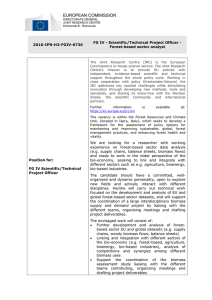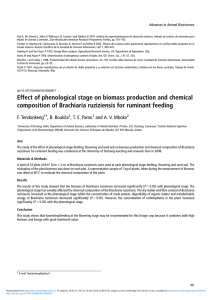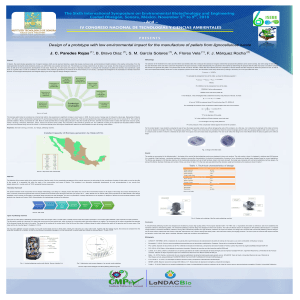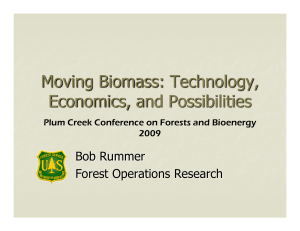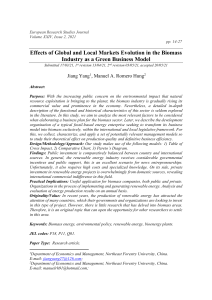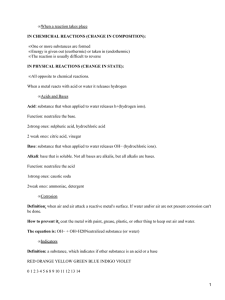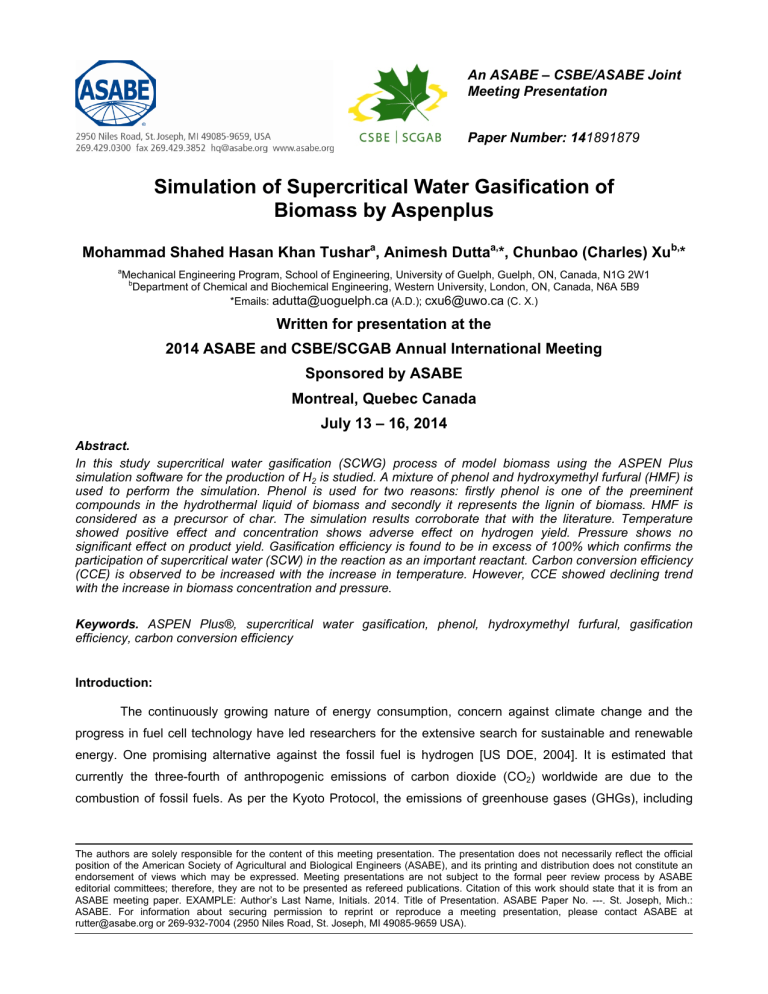
An ASABE – CSBE/ASABE Joint Meeting Presentation Paper Number: 141891879 Simulation of Supercritical Water Gasification of Biomass by Aspenplus Mohammad Shahed Hasan Khan Tushara, Animesh Duttaa,*, Chunbao (Charles) Xub,* a Mechanical Engineering Program, School of Engineering, University of Guelph, Guelph, ON, Canada, N1G 2W1 b Department of Chemical and Biochemical Engineering, Western University, London, ON, Canada, N6A 5B9 *Emails: [email protected] (A.D.); [email protected] (C. X.) Written for presentation at the 2014 ASABE and CSBE/SCGAB Annual International Meeting Sponsored by ASABE Montreal, Quebec Canada July 13 – 16, 2014 Abstract. In this study supercritical water gasification (SCWG) process of model biomass using the ASPEN Plus simulation software for the production of H2 is studied. A mixture of phenol and hydroxymethyl furfural (HMF) is used to perform the simulation. Phenol is used for two reasons: firstly phenol is one of the preeminent compounds in the hydrothermal liquid of biomass and secondly it represents the lignin of biomass. HMF is considered as a precursor of char. The simulation results corroborate that with the literature. Temperature showed positive effect and concentration shows adverse effect on hydrogen yield. Pressure shows no significant effect on product yield. Gasification efficiency is found to be in excess of 100% which confirms the participation of supercritical water (SCW) in the reaction as an important reactant. Carbon conversion efficiency (CCE) is observed to be increased with the increase in temperature. However, CCE showed declining trend with the increase in biomass concentration and pressure. Keywords. ASPEN Plus®, supercritical water gasification, phenol, hydroxymethyl furfural, gasification efficiency, carbon conversion efficiency Introduction: The continuously growing nature of energy consumption, concern against climate change and the progress in fuel cell technology have led researchers for the extensive search for sustainable and renewable energy. One promising alternative against the fossil fuel is hydrogen [US DOE, 2004]. It is estimated that currently the three-fourth of anthropogenic emissions of carbon dioxide (CO2) worldwide are due to the combustion of fossil fuels. As per the Kyoto Protocol, the emissions of greenhouse gases (GHGs), including The authors are solely responsible for the content of this meeting presentation. The presentation does not necessarily reflect the official position of the American Society of Agricultural and Biological Engineers (ASABE), and its printing and distribution does not constitute an endorsement of views which may be expressed. Meeting presentations are not subject to the formal peer review process by ASABE editorial committees; therefore, they are not to be presented as refereed publications. Citation of this work should state that it is from an ASABE meeting paper. EXAMPLE: Author’s Last Name, Initials. 2014. Title of Presentation. ASABE Paper No. ---. St. Joseph, Mich.: ASABE. For information about securing permission to reprint or reproduce a meeting presentation, please contact ASABE at [email protected] or 269-932-7004 (2950 Niles Road, St. Joseph, MI 49085-9659 USA). CO2, should be limited. As such, hydrogen (H2) has a significant future potential as an alternative energy carrier that can help to mitigate the problems of CO2 emissions. Hydrogen is abundant in nature and generously distributed throughout the world disregarding the national boundaries. To create a hydrogen economy (a future energy system based on hydrogen and electricity), ‘technology’ is the major factor since hydrogen is not freely available in nature; rather a suitable ‘technology’ is required to extract it from a primary natural source, mainly hydrocarbons. As such, like electricity, hydrogen is an energy carrier, and it must be produced from a source [Crabtree et al., 2004]. One of the techniques to produce hydrogen is by supercritical water gasification (SCWG) of biomass. Supercritical water (SCW) is a green solvent and highly reactive for biomass thermochemical conversion reactions. Non-polar, organic compounds can be dissolved in SCW while they cannot be normally dissolved in liquid water or steam. The absence of phase boundaries and high diffusivity in SCW leads to rapid and complete reactions [Bazargan et al., 2005; Dinjus and Kruse, 2004]. This in turn lead to higher conversions of the solid material to fuel gas, and less solid residue can be achieved by SCWG relative to conventional direct or indirect gasification in air or steam [Demirbas, 2005; Yanik et al., 2007]. It is an established fact that biomass has a great potential as a substitute of conventional and nonrenewable fossil fuel because of its features like renewability and carbon neutrality. However more than 90% of the global annual amount of terrestrial plant biomass which corresponding to 57 × 109 tonnes of elemental carbon – is not digestible by humans. This huge renewable resource may thus be used for fuel or chemical purposes without competition with the food industry [Clark and Deswarte, 2008; Imhoff et al., 2004; Lange, 2007; Roland et al., 2011]. Besides, dairy manure, water hyacinth and algae are widely available around the world. These biomasses are considered as low grade biomass because they contain more than 70% moisture. SCWG process is one of the most effective ways to utilize these biomasses to convert into combustible gases and useful products. In contrast to the traditional gasification process that requires dried biomass for the process, SCWG utilizes the water and moisture content of the biomass to produce usable gaseous products. The behavior of supercritical water becomes very unique beyond the critical point of water (Tc = 374.15 °C and Pc = 22.064 MPa). Water becomes as a single phase fluid which overcomes any mass transfer limitation during the process. Also at supercritical condition, water becomes almost a non-polar substance [Kruse and Dinjus, 2007]. At this condition, many organic substances including the precursors of tar and char (mainly polycyclic aromatic hydrocarbons) becomes soluble in SCW. Therefore, many SCWG show almost zero tars or chars formation during the process [Chuntanapum and Matsumura, 2010; Hao et al., 2003]. From the open literature, many good researches have been done so far and some good reviews are also available on SCWG [Basu and Mettanant, 2009; Elliot, 2008; Guo et al., 2010; Hao and Guo, 2001; Kruse, 2008; Matsumura et al., 2005; Peterson et al., 2008; Savage et al., 2010]. The available literatures investigated different biomasses, ranging from simple model compounds to lignocellulosic biomasses, mostly by experimentation. Researchers also tried several catalysts which are also reviewed by some researchers and the citations are provided in this same paragraph. A few researchers also have been performed in the field of kinetic modeling and simulation of SCWG using biomass [Castello and Fiori, 2011; Guan et al., 2012; Huelsman and Savage, 2012; Kabyamela et al., 1997; Matsumura et al., 2006; Sasaki et al., 2004]. In the present paper, simulation of a mixture of phenol and hydroxymethyl furfural is performed using 2014 ASABE – CSBE/SCGAB Annual International Meeting Paper Page 1 Aspenplus® software. The main reason is, phenol is the major compound that is produced due to hydrothermal liquefaction of lignocellulosic biomass, mainly from lignin [Anastasakis and Ross, 2011; Theegala and Midgett, 2012; Vardon et al., 2011]. Hydroxymethyl furfural (HMF) is chosen because it is a precursor for the tar [Chuntanapum and Matsumura, 2009; Gandini and Belgacem, 1997]. Antal et al. [1990] has outlined the formation of hydroxy methyl furfural from sugars. The purpose of the project is to perform simulation of hydrogen production from biomass and effect of different parameters on it. Methods: Biomass As mentioned in the introduction, two different biomass substrates are used in this study which are promising candidates for the SCWG process and represent the lignocellulosic biomasses: phenol and HMF. Phenol can be considered as a representative of lignin and HMF is chosen to represent a precursor of tar and to make the process more realistic. Table 1 shows the various biomass used for the simulation process. Table 1: Biomass compositions and heating values Biomass Formula HHV (MJ/kg)* Phenol C6H6O 34.48 HMF C5H4O2 24.02 *heating values are calculated based on Friedl et al., 2005. Aspenplus® simulation: The first objective of this study is to design a simple process lay out for the SCWG of biomass and production of H2. The process flow is kept as simple as possible for future modification and scaling up. Besides, as part of the design, the process must be self-sustainable and convenient from the energy point of view. The basic flow diagram of the process is shown in figure 1 and the Aspenplus® flow diagram in figure 2. Biomass H2O Mixer Reactor Storage Tank H2 CO2 CO CH4 Separator Liquid effluent Figure 1: Process flow diagram of SCWG AspenPlus® simulations were performed at various operating conditions, i.e. at different temperatures (500, 550, 600, 650 and 700°C), pressures (23, 28, 33, 38, 43 and 48 MPa) and feed concentrations (biomass in the feed stream ranging from 5% to 35%, balance water). The ranges for the operating conditions are 2014 ASABE – CSBE/SCGAB Annual International Meeting Paper Page 2 chosen randomly between the lower and upper limits used by the researchers. The highest pressure reported so far in the literature is 68 MPa in an autoclave reactor [Kruse and Dinjus, 2003] and temperature is 800°C [Byrd et al., 2007; 2008; Hendry et al., 2011; Kersten et al., 2006]. S1 S2 MIXER TANK PUMP S3 RCTR HX1 S5 S6 HX2 S7 S4 S11 S8 SPRTR BPR S9 S12 Figure 2: Schematic flow sheet of the SCWG for hydrogen production by Aspenplus® To better understanding of the process, a description relevant to the SCWG of a feed stream with 5% mixture of phenol and HMF at 700°C and 28 MPa will be reported. The process type was chosen as COMMON which allotted a generic industry type to the simulation, as opposed to chemical, petrochemical, pharmaceutical, etc. The IDEAL base calculation method was selected for simplicity and thus phase equilibrium calculations were conducted using Raoult’s Law, Henry’s Law, ideal gas law, etc. The input of the plant is made up of two flows, a mixture of phenol (2.5 kg/h) and HMF (2.5 kg/h) and rest water (95 kg/h). Both the streams are at standard conditions, i.e. 20°C and 0.101 MPa. The solution is then stored in the tank and pumped to the reactor (RCTR) at working pressure (28 MPa). The flow is first heated up by a heat exchanger (HX1). In the process flow system, both the heat exchangers are interconnected for optimum use. Any makeup coolant (or heating fluid) connection is not shown in the system. HX1 uses the heat rejected by the hot gas stream at the HX2 to preheat the feed that goes to reactor. The reactor was modeled using RGibbs based on the minimization of the Gibbs free energy. The fluid streams and biomasses were modelled using conventional components which have thermophysical data stored in ASPEN Plus databanks. Therefore, no data input were required for these components. The components include: phenol (C6H6O, 50%) and furfural (C5H4O2, 50%), hydrogen (H2), water (H2O), carbon monoxide (CO), carbon dioxide (CO2), methane (CH4), and oxygen (O2). Throughout the process, the reactor was kept at constant pressure (28 MPa) and temperature (700°C). The resulting stream (S7) containing the product gas was first cooled in the heat exchanger (HX2) after 2014 ASABE – CSBE/SCGAB Annual International Meeting Paper Page 3 leaving the reactor, where it lost the heat and this heat was used to preheat the feed stream to the reactor. Subsequently, the stream S7 is cooled at 20°C in order to separate water (block SPRTR). In this unit 87.533 kg/hr of water can be recovered, meaning that the water consumption due to the reaction amounts to 7.467 kg/hr. This recovered water can again be used for another gasification experiment with adding some make-up water. Considering the biomass composition provided in Table 1, the process itself determines the possible reaction products which are H2O, H2, CO, CO2 and CH4. Since previous thermodynamic calculations (Castello and Fiori, 2011; Gutierrez Ortiz et al., 2012) did not show the higher molecular weight hydrocarbons (C2H4, C2H6, etc.), they are not considered as the SCWG products. As mentioned before, the excess water exiting the separator can be reintegrated into the process to reduce the water consumption. The input and operating conditions for all feed streams and block units are summarized in Table 2 and 3 respectively to demonstrate a simulation with a mixture of phenol and HMF, assuming a feed concentration of 5% and a reaction occurring at 700 °C and 28 MPa. Table 2: Block unit operating conditions Block Information Name Operating Conditions Type Temperature Pressure (°C) (MPa) Other RCTR RGibbs 700 28 − BPR Valve 20 28 PUMP Pump 20 28 TANK Tank 20 0.101 − MIXER Mixer 20 0.101 − HX1 Heater 200 28 − HX2 Heater 20 28 − SPRTR Separator 20 0.101 Pressure reducer – reduces pressure from 28 MPa to 0.101 MPa Pressurizer – increases pressure from 0.101 MPa to 28 MPa Separates gaseous components (H2, CO, CO2, and CH4) from liquid H2O. Table 3: Feed stream input conditions Input Conditions Temperature Pressure Flowrate Feed Stream (°C) (MPa) (kmol/h) S1 20 ≈0.101 5 Phenol+HMF (Conventional) S2 20 ≈0.101 95 H2O (Conventional) Component Results and discussion: 2014 ASABE – CSBE/SCGAB Annual International Meeting Paper Page 4 Effect of reaction temperature on product yield Figure 3: Effect of temperature on product gas yield of the mixture of phenol and HMF; P = 28MPa, biomass concentration 5% Temperature has dominating effects on hydrogen yield. With an increase in temperature the hydrogen yield increases while the methane yield decreases. Thermodynamically at lower reaction temperatures, H2 and CO2 readily react to form methane and water via the methanation reaction. A higher temperature could limit the methanation reaction and promote water gas shift reaction, leading to low CH4 and CO formation. In a SCWG process, the presence of excess water leads to a preference for the formation of H2 and CO2 instead of CO. Figure 3 shows the effect of temperature on product gas yield. As clearly seen from the figure the hydrogen production increases with the increase in temperature. Followings are the conversion reactions which may take place during the SCWG of phenol and HMF. Equation (2) and (3) represents water-gas shift reaction and methanation reaction respectively which are reversible. C H O C H O CO H O ↔ CO CH 2H O ↔ CO 16H O → 19H 9CO CH H CO ………………………………. (1) …………………………………… (2) 4H …..……………………………….. (3) The formation reactions of hydrogen and methane have opposite characteristics. The formation of hydrogen is endothermic whereas the formation of methane is exothermic [Lu et al., 2006], which implies that with the increase in temperature, hydrogen and carbon dioxide yields increase as per the Le Chatelier’s principle. On the contrary, methane yield decreases with increasing temperature based on the same principle. A higher temperature favors free-radical reactions, and hence enhances reaction rates, which improves gas yield [Lu et al., 2008]. Furfural and phenol are ring compounds with complex carbon bonding in the structure [Figure 4]. Initially CH4 production is higher as at lower temperature due to insufficient thermal energy to break the bonds to produce H2. However, with the increase in temperature, the bonds of phenol and HMF tend to break to produce H2 [Huelsman and Savage, 2012]. It is also reported that [Aida et al., 2002] retro-Friedel-Crafts reaction occurs for carbon-carbon bonds for phenolic compounds and alcohol or aldehyde. Nevertheless, the 2014 ASABE – CSBE/SCGAB Annual International Meeting Paper Page 5 formation of cross-linkage occurs for phenolic structures due to the exorbitantly high reactivity for phenol to aldehyde (Friedel-Craft reaction) [Dorrestijin et al., 2000]. This phenomenon makes a complete dissolution of phenolic compounds in supercritical water difficult which results lower hydrogen production and higher methane production from the mixture of phenol and HMF. Figure 4: Structures of the biomass compounds used in simulation Effect of concentration on product yield Figure 5: Effect of concentration on product yield; P = 28 MPa, T = 700 °C Feed concentration has significant effect on gasification efficiencies and yields too, although it does not show a significant effect on the gasification rate. Figure 5 shows increased feed concentration resulted in decreased H2 yield but an increased CH4 yield [Susanti et al., 2012]. At equilibrium condition, the concentration plays an important role to finish the reaction. Usually CH4 yield increases at higher feed concentrations, which is likely due to the lack of water that restricts the methane reforming reaction [Manarungson et al., 1990]. This can be explained as follows. The decarbonylation and decarboxylation of phenol and HMF is reduced due to 2014 ASABE – CSBE/SCGAB Annual International Meeting Paper Page 6 higher concentration. Also the reverse water gas shift reaction may takes place which slightly increases the production of CO. Also higher concentration favors the methanation reaction which is the reverse of reaction 3 [Huelsman and Savage, 2012; Resende and Savage, 2010]. Effect of pressure on product yield The effects of pressure on the mechanism of supercritical gasification of biomass are however very complicated. It is observed that the density and ion product of water increase with the increase in pressure while the other parameters such as temperature, substrate concentration, and flow rate are remained constant. The gas production is facilitated by the hydrolysis reaction and water gas shift reaction which can be achieved by faster ion reactions due to the increase in the rates at higher pressure. Au contraire, gas formation reactions via free radicals is inhibited due to restriction of free-radical reactions at higher pressure [Bühler et al., 2002]. From Le Chatelier’s principle, a reaction that produces more molecules is inhibited at high pressure region. Thus, the gasification process is generally favored at lower pressure [Sato et al., 2006]. The combined effects of pressure result in the complicated effects of pressure on SCWG [Lu et al., 2006]. Figure 6 shows that the reactor pressure does not have significant effect on SCWG of biomass. The special physical and chemical properties of SCW disappear when the pressure is below the critical point, which could inhibit hydrogen production. However, operation at high pressure greatly increased operating cost. As a result, it is a common practice to keep the operating pressure below 30 MPa for a SCWG process to balance the effects of pressure on hydrogen yield and the operating costs [Jin et al., 2010]. Figure 6: Effect of pressure on gas yield 5% phenol + HMF; T = 700 °C Gasification efficiency (GE) The GE measures the conversion of the feedstock to product gases and can be defined as the ratio of the sum of the masses of product gases (Mg) with that of the feedstock (Mf). Mathematically it can be written as follows ∑ ……………………...…………………………………………… (4) Figure 7 shows the variation of the GE with the variation of temperatures, pressures and 2014 ASABE – CSBE/SCGAB Annual International Meeting Paper Page 7 concentrations. According to the figure, the GE is in excess of 100%, which proves the participation of the SCW in the reaction as an important reactant and thusly becomes a source of hydrogen production. This result corroborates with those of Antal et al. [1994], Hao et al. [2003] and Yan et al. [2006]. As it is mentioned in the model, water is consumed during the gasification process. For a mixture of 2.5 kg phenol and 2.5 kg HMF reacts with 7.467 kg per hour. This finding is confirmed by the Figure 7 where most of the GE are around 200%. Figure 7: Gasification efficiency at different conditions Carbon conversion efficiency (CCE) The carbon conversion (carbon efficiency) is defined as degree of conversion of carbon from biomass to permanent gases [Sricharoenchaikul, 2009]: ∑ , , 100 ……………………………………………………… (5) where Mc,i = mass of carbon in component i produced, mol Mc, feed = mass of carbon in a feed Figure 8 shows the comparison of the simulation results with the experimental data for carbon conversion efficiency versus temperature in the range of 700–900 °C, biomass concentration range 5% − 35% and pressure range 23 – 48 MPa. Temperature shows positive effect on CCE as higher temperature favors the reaction completion. However, pressure and biomass concentration showed adverse effect on CCE. It is 2014 ASABE – CSBE/SCGAB Annual International Meeting Paper Page 8 reported earlier that for a mixture of 2.5 kg phenol and 2.5 kg of HMF consumes 7.467 kg of water per hour during the SCWG process. By comparing the amounts, it can be said that higher biomass concentration and pressure cause the reduction in CCE. Figure 8: Carbon conversion efficiency at different operating condition: (a) temperature, (b) biomass concentration, (c) pressure Conclusion The Aspenplus® simulation of SCWG of biomass used in this study reveals systematically the effect of operating parameters on product yield under the following range of conditions: temperature of 500–700 °C, pressure of 23–48 MPa and concentration of 5–35 wt%. The simulation method used a very simple approach to find the effects of these parameters on the product yield. According to the simulation, temperature showed the prominent effect while pressure did not show any significant effect on the product yield. Concentration has negative effect on the product gas. With the increase in concentration, hydrogen production decreased while methane production increased. The trend of simulations is in good agreement with literatures. The gasification efficiency is around 200% as higher amount of water is consumed during the gasification process. It is also observed that temperature has positive effect on the carbon conversion efficiency whereas biomass concentration and pressure has adverse effect on carbon conversion efficiency which is not significant. 2014 ASABE – CSBE/SCGAB Annual International Meeting Paper Page 9 References Aida, T. M., Sato, T., Sekiguchi, G., Adschiri, T. & Arai, K. (2002) Extraction of Taiheiyo coal with supercritical water–phenol mixtures. Fuel, 81(11), pp. 1453-1461. Anastasakis, K. & Ross, A. B. (2011) Hydrothermal liquefaction of the brown macro-alga Laminaria Saccharina: Effect of reaction conditions on product distribution and composition. Bioresource technology, 102(7), pp. 4876-4883. Amin, S., Reid, R. C. & Modell, M. (1975) Reforming and Decomposition of Glucose in an Aqueous Phase. Proceedings of the Intersociety Conference on Environmental Systems, San Francisco, CA, 1975; The American Society of Mechanical Engineers (ASME): New York; ASME Paper No. 75-ENAs-21, 1. Antal, M. J., Mok, W. S. & Richards, G. N. (1990) Mechanism of formation of 5-(hydroxymethyl)-2-furaldehyde from D-fructose and sucrose. Carbohydrate research, 199(1), pp. 91-109. Bazargan, M., Fraser, D. & Chatoorgan, V. (2005) Effect of buoyancy on heat transfer in supercritical water flow in a horizontal round tube. J Heat Transfer. 27, pp. 897–902. Basu, P. & Mettanant, V. (2009) Biomass Gasification in Supercritical Water--A Review. International Journal of Chemical Reactor Engineering, 7(1), pp. 1-62. Bühler, W., Dinjus, E., Ederer, H. J., Kruse, A. & Mas, C. (2002) Ionic reactions and pyrolysis of glycerol as competing reaction pathways in near-and supercritical water. The J Supercritical Fluid 22(1): 37-53. Byrd, A. J., Pant, K. K. & Gupta, R. B. (2007) Hydrogen production from glucose using Ru/Al2O3 catalyst in supercritical water. Industrial & engineering chemistry research. 46(11). pp. 3574-3579. Byrd, A. J., Pant, K. K. & Gupta, R. B. (2008) Hydrogen production from glycerol by reforming in supercritical water over Ru/Al2O3 catalyst. Fuel. 87(13). pp. 2956-2960. Castello, D. & Fiori, L. (2011) Supercritical water gasification of biomass: thermodynamic constraints. Bioresource technology, 102(16), pp. 7574-7582. Chuntanapum, A. & Matsumura, Y. (2009) Formation of tarry material from 5-HMF in subcritical and supercritical water. Industrial & Engineering Chemistry Research, 48(22), pp. 9837-9846. Chuntanapum, A. & Matsumura, Y. (2010) Char formation mechanism in supercritical water gasification process: A study of model compounds. Industrial and Engineering Chemistry Research, 49 (9) pp. 4055-4062. Clark, J. H. & Deswarte, F. (Eds.). (2008) Introduction to chemicals from biomass. John Wiley & Sons (WileyVCH), West Sussex, UK. Crabtree, G. W., Dresselhaus, M. S. & Buchanan, M. V. (2004) The hydrogen economy. Physics Today, 57(12), 39-44. Demirbas A. 2004. Hydrogen-rich gas from fruit shells via supercritical water extraction. International Journal of Hydrogen Energy. 29 (12), pp. 1237-1243. Demirbas, A. 2005. Hydrogen production from biomass via supercritical extraction. Energy Sources. 27(15), 2014 ASABE – CSBE/SCGAB Annual International Meeting Paper Page 10 pp. 1409–1417. Dinjus, E. & Kruse, A. (2004) Hot compressed water – a suitable and sustainable solvent and reaction medium? J Phys: Condens Matter. 16:S1, pp. 161–169. Dorrestijn, E., Laarhoven, L. J., Arends, I. W. & Mulder, P. (2000) The occurrence and reactivity of phenoxyl linkages in lignin and low rank coal. Journal of Analytical and Applied Pyrolysis, 54(1), pp. 153-192. Elliott, D. C. 2008. Catalytic hydrothermal gasification of biomass. Biofuels, Bioproducts and Biorefining, 2(3), pp. 254-265. Friedl, A., Padouvas, E., Rotter, H. & Varmuza, K. (2005) Prediction of heating values of biomass fuel from elemental composition. Analytica Chimica Acta, 544(1), 191-198. Gandini, A. & Belgacem, M. N. (1997) Furans in polymer chemistry. Progress in Polymer Science, 22(6), pp. 1203-1379. Guan, Q., Wei, C. & Savage, P. E. (2012) Kinetic model for supercritical water gasification of algae. Physical Chemistry Chemical Physics, 14(9), pp. 3140-3147. Guo, Y., Wang, S. Z., Xu, D. H., Gong, Y. M., Ma, H. H. & Tang, X. Y. (2010) Review of catalytic supercritical water gasification for hydrogen production from biomass. Renewable and Sustainable Energy Reviews, 14(1), 334-343. Gutiérrez Ortiz, F. J., Ollero, P., Serrera, A. & Galera, S. (2012) An energy and exergy analysis of the supercritical water reforming of glycerol for power production. International Journal of Hydrogen Energy, 37(1), 209-226. Hao, X. & Guo, L. (2001). A review on investigation of hydrogen production by biomass catalytic gasification in supercritical water. Journal of Chemical Industry and Engineering (China), 53(3), 221-228. Hao, X.H., Guo, L.J., Mao, X., Zhang, X.M. & Chen, X.J. (2003) Hydrogen production from glucose used as a model compound of biomass gasified in supercritical water, International Journal of Hydrogen Energy, 28 (1) , pp. 55-64. Hendry, D., Venkitasamy, C., Wilkinson, N. & Jacoby, W. (2011) Exploration of the effect of process variables on the production of high-value fuel gas from glucose via supercritical water gasification. Bioresource technology. 102(3). pp. 3480-3487. Holgate, H. R., Meyer, J. C. & Tester, J. W. (1995) Glucose hydrolysis and oxidation in supercritical water. AIChE Journal, 41(3), 637-648. Huelsman, C. M. & Savage, P. E. (2012) Intermediates and kinetics for phenol gasification in supercritical water. Physical Chemistry Chemical Physics, 14(8), pp. 2900-2910. Imhoff, M. L., Bounoua, L., Ricketts, T., Loucks, C., Harriss, R. & Lawrence, W. T. (2004) Global patterns in human consumption of net primary production. Nature. 429(6994). pp. 870-873. Jin, H., Lu, Y., Guo, L., Cao, C. & Zhang, X. (2010) Hydrogen production by partial oxidative gasification of biomass and its model compounds in supercritical water. International Journal of Hydrogen Energy, 2014 ASABE – CSBE/SCGAB Annual International Meeting Paper Page 11 35(7): 3001-3010. Kabyemela, B. M., Adschiri, T., Malaluan, R. M. & Arai, K. (1997) Kinetics of glucose epimerization and decomposition in subcritical and supercritical water. Industrial & engineering chemistry research, 36(5), 1552-1558. Kersten, S. R., Potic, B., Prins, W. & Van Swaaij, W. P. (2006) Gasification of model compounds and wood in hot compressed water. Industrial & engineering chemistry research. 45(12). pp. 4169-4177. Kruse, A. 2008. Supercritical water gasification. Biofuels, Bioproducts and Biorefining, 2(5), 415-437. Kruse, A. & Dinjus, E. (2003) Hydrogen from Methane and Supercritical Water. Angew. Chem., Int. Ed. 42(8). pp. 909 – 911. Kruse, A. & Dinjus, E. (2007) Hot compressed water as reaction medium and reactant. Properties and synthesis reactions. Journal of Supercritical Fluids. 39 (3) , pp. 362-380. Lange, J. P. 2007. Lignocellulose conversion: an introduction to chemistry, process and economics. Biofuels, bioproducts and biorefining. 1(1). pp. 39-48. Lee, I. G. & Ihm, S. K. (2008) Catalytic gasification of glucose over Ni/activated charcoal in supercritical water. Industrial & Engineering Chemistry Research, 48(3), 1435-1442. Lu, Y. J., Guo, L. J., Ji, C. M., Zhang, X. M., Hao, X. H. & Yan, Q. H. (2006) Hydrogen production by biomass gasification in supercritical water: a parametric study. International Journal of Hydrogen Energy, 31(7), 822-831. Lu, Y. J., Jin, H., Guo, L. J., Zhang, X. M., Cao, C. Q. & Guo, X. (2008) Hydrogen production by biomass gasification in supercritical water with a fluidized bed reactor. International Journal of Hydrogen Energy, 33(21), 6066-6075. Manarungson, S., Mok, W. S. & Antal, M. J. (1990) Gasification of glucose and wet biomass in supercritical water. in Hydrogen Energy Progress VIII, T Veziroglu and P K Takahashi, eds. 345-355. Matsumura, Y., Minowa, T., Potic, B., Kersten, S. R., Prins, W., van Swaaij, W. P., Beld, B., Elliot, D. C., Neuenschwander, G. G., Kruse, A. & Antal., M. J. (2005) Biomass gasification in near-and supercritical water: status and prospects. Biomass and Bioenergy, 29(4), 269-292. Matsumura, Y., Yanachi, S. & Yoshida, T. (2006) Glucose decomposition kinetics in water at 25 MPa in the temperature range of 448-673 K. Industrial & engineering chemistry research, 45(6), pp. 1875-1879. Peterson, A. A., Vogel, F., Lachance, R. P., Fröling, M., Antal Jr, M. J. & Tester, J. W. (2008) Thermochemical biofuel production in hydrothermal media: a review of sub-and supercritical water technologies. Energy & Environmental Science, 1(1), 32-65. Resende, F. L. & Savage, P. E. (2010) Kinetic model for noncatalytic supercritical water gasification of cellulose and lignin. AIChE journal, 56(9), 2412-2420. Sasaki, M., Adschiri, T. & Arai, K. (2004) Kinetics of cellulose conversion at 25 MPa in sub‐and supercritical water. AIChE Journal, 50(1), 192-202. 2014 ASABE – CSBE/SCGAB Annual International Meeting Paper Page 12 Sato, T., Furusawa, T., Ishiyama, Y., Sugito, H., Miura, Y., Sato, M., Suzuki, N. & Itoh, N. (2006) Effect of water density on the gasification of lignin with magnesi-um oxide supported nickel catalysts in supercritical water. Industrial and Engineering Chemistry Research, 45(2): 615-622. Savage, P. E., Levine, R. B. & Huelsman, C. M. (2010) Hydrothermal processing of biomass, in: Thermochemical Conversion of Biomass to Liquid Fuels and Chemicals, ed. M. R. Crocker, Royal Society of Chemistry, London. pp. 190–219 Sricharoenchaikul, V. 2009. Assessment of black liquor gasification in supercritical water. Bioresource technology, 100(2), 638-643. Susanti, R. F., Dianningrum, L. W., Yum, T., Kim, Y., Lee, B. G. & Kim, J. (2012) High-yield hydrogen production from glucose by supercritical water gasification without added catalyst. International Journal of Hydrogen Energy, 37(16), 11677-11690. Theegala, C. S. & Midgett, J. S. (2012) Hydrothermal liquefaction of separated dairy manure for production of bio-oils with simultaneous waste treatment. Bioresource technology, 107, pp. 456-463. US Department of Energy. 2004. Basic Research Needs for the Hydrogen Economy. Office of Basic Energy Sciences, US DOE, Washington, DC (2004), available at http://www.sc.doe.gov/bes/hydrogen.pdf US Energy Information Administration. 2013. International Energy Outlook, 2013. Report Number: DOE/EIA0484(2013), available at http://www.eia.gov/forecasts/ieo/index.cfm. Vardon, D. R., Sharma, B. K., Scott, J., Yu, G., Wang, Z., Schideman, L., Zhang, Y. & Strathmann, T. J. (2011) Chemical properties of biocrude oil from the hydrothermal liquefaction of Spirulina algae, swine manure, and digested anaerobic sludge. Bioresource technology, 102(17), pp. 8295-8303. Yanik, J., Ebale, S., Kruse, A., Saglam, M. & Yüksel, M. (2007) Biomass gasification in supercritical water: part 1. Effect of the nature of biomass. Fuel. 86, pp. 2410–2415. 2014 ASABE – CSBE/SCGAB Annual International Meeting Paper Page 13

